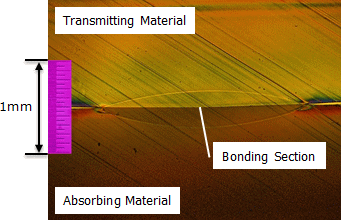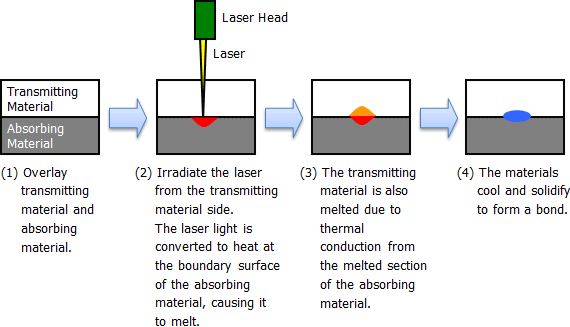Home > Technical Support > Adhesion and Welding Technology
Material Technology for Laser Welding
| Polyplastics Offers Broad Slate of Engineering Thermoplastics for Laser Welding |
|---|
| 1. Introduction |
One-hundred years ago, phenolic resin was born as the first synthetic polymer made from non-plant materials. Since then, a good variety of plastics have been developed and their applications have broadened. Plastic was originally used for everyday items such as cups and plates, then its use grew to include electronics such as TVs and smartphones, as well as automotive and aircraft components. Polyplastics' engineering plastics have excellent heat resistance and strength, in addition to the typical advantages of plastic materials such as being lightweight, having electrical insulation properties and being rustproof. For this reason, they are often used in the automotive and electrical / electronic fields, where durability is essential. Housings that protect components such as circuit boards, sensors and actuators from moisture, dust or damage are one of their typical applications. Various methods are utilized for the bonding of these plastic housings, such as adhesion, screw fastening, caulking and welding. On this page, we will introduce one such bonding method—laser welding technology. |
| 2. Laser Welding | |
Welding is one of the methods for bonding thermoplastic resin parts. In this method, heat is applied to melt a certain section of the resin product, then the parts are stuck together, cooled and solidified to form a bond. Typical methods of welding include ultrasonic welding, vibration welding and hot plate welding. Among them, laser welding has grown popular over the past decade. |
 |
Laser welding is a bonding method that utilizes the laser transmissibility of a plastic material on one side (transmitting material), and another material containing additives such as carbon black that absorb laser light (absorbing material) on the other side. Figure 1 shows the laser welding process. |
|
 |
| Figure 1. Laser Welding Process |
|---|
The wavelength of lasers used in laser welding, such as diode lasers or YAG lasers, is approximately 800 - 1,200nm. This is slightly longer than the wavelength of visible light. The type of resin materials suitable for laser welding are those which exhibit high enough laser transmissibility and absorbability in this wavelength range. For colored materials, the selection of suitable color pigments and laser absorbers is important. When using conventional welding methods, there is a considerable possibility of ultrasonic waves, vibrations and radiant heat causing damage to precision components inside housings (circuit boards, sensors, etc.). On the other hand, laser welding allows for pinpoint accuracy in the melting of the bonding sections, with none of the ill-effects as described above. The ability to bond complex shapes and the potential for automation are other reasons for the growing popularity of laser welding.
Table 1 shows the compatibility of Polyplastics products with laser welding. DURACON® POM and TOPAS® COC are suitable for laser welding, with few exceptions. DURANEX® PBT, DURAFIDE® PPS and LAPEROS® LCP can be laser welded under certain conditions, such as choosing the suitable product thickness. |
Table 1. Laser Weldability of Polyplastics Resins |
| Resin | POM | PBT | PPS | LCP | COC |
|---|---|---|---|---|---|
| Polyplastics Product Name | DURACON® | DURANEX® | DURAFIDE® | LAPEROS® | TOPAS® |
| Laser Weldability | ◯ | △ | △ | △ | ◯ |
| ◯ : Suitable; △ : Possible Under Certain Conditions |
Merits of Laser Welding |
• There is no damage to internal precision components such as circuit boards since no heat, vibration or ultrasonic waves are applied to the product directly. • Excellent appearance and design due to the absence of wear debris and few welding burrs. • There is little change to the product dimensions before and after welding. There is also little variation in these dimensional changes. • The bonding section does not need to be formed into a special joint shape. • Any part can be welded, offering excellent design freedom. • The welding process does not create noise or vibrations. This provides an excellent work environment. |
Cautions Regarding Laser Welding |
• The clearance between welding interfaces should be kept at 0.1mm or lower. • Injection molding gates should not be located on or near the welding section. • For commercial products, the transmitting material should have a transmittance of approximately 20% or more. • The welding section of the transmitting material should be of uniform thickness. • Contaminants are a cause of poor welding. Ensure that none are incorporated into the transmitting material. • Excessive laser output carbonizes and degrades the resin. Select appropriate welding conditions. |
3. Laser Welding of DURANEX® PBT |
PBT is a cost-balanced resin that exhibits excellent heat resistance, moldability and electrical properties. It is therefore widely utilized for applications such as housings. Figure 2 shows the transmission spectrum of PBT with a thickness of 1mm. The transmissibility of PBT resin is … |
|
||||||
16th January 2018 |

